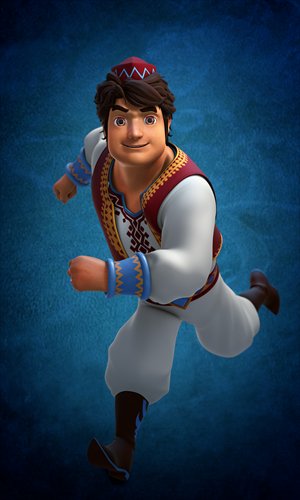

Tuerdo, a main character of the cartoon series Princess Fragrant. Photo: Courtesy of Shenzhen Qianheng Cultural Communication Company
When Huang Zhiyong, director of Loulan Legend, based on the rise and fall of the Loulan kingdom, built in 176 BC, tested the waters with Xinjiang's first local cartoon last year, he spent over half a year in Xinjiang before he even started.
"At the very beginning, I had little knowledge of Xinjiang and I spent a large amount of time wandering around in the big bazaar and the Uyghur-populated areas, as well as the museums," Huang said.
He visited the relics of Loulan frequently and read a large number of local archives before he started to make the cartoon, Huang said.
With rich cultural resources and ethnic legends, Xinjiang abounds with good material for the cartoon industry. With eight neighboring Central Asian countries, the geological location also offers unique opportunities for the Xinjiang region to develop its cartoon industry in Central Asia.
Qarluq Technology Company is the first animation company established in Xinjiang that focuses on 3D productions. The company, most of whose employees are Uyghur people, has been expanding its market in foreign countries, including Iran, Kazakhstan and other countries, by using its language and geological advantages.
"We have cultural closeness with neighboring and Middle East countries. To promote a modern and open Xinjiang to the world is the aim of our cartoon works," Azizaim Abudulah, director of operational department from Qarluq company, told the Global Times.
Azizaim noted a lack of manpower and expensive equipment has become a hurdle for the development of cartoons in Xinjiang. The rendering work of one cartoon produced for Iran customers was put on hiatus due to the lack of a rendering machine.
There has no official number on how many cartoon companies register and make cartoons in Xinjiang, but, Sheng said, there has an evident increase in numbers in recent years.
Based on legendary local figures and with its distinct geographical locations, most of the cartoons made in Xinjiang are imprinted with strong ethnic characteristics.
Boost ethnic solidarity
Xinjiang authorities support the development of cartoons with the aim of maintaining social stability by boosting the solidarity of Han and Uyghur people and the fusion of Han and Uyghur culture, Sheng Jun noted.
Critics say deepening gaps between Han and Uyghur ethnic groups impose a huge threat to social stability in Xinjiang. The repeated violence in Xinjiang as well as some inland cities, plotted by terrorists, have rattled people's nerves and alienated ethnic relationships consequently.
The violence also implicated the cultural industry. On August 13, dozens of Xinjiang artists wrote a public letter criticizing the separatists, religious extremists and terrorists that "besiege Uyghur modern culture and destroy art and traditions" using the cover of religion to break traditional folk customs; for example, pressuring young women to cover their face and body. They also called on authorities to use diversified art forms to pass on "positive energy."
To improve the current situation and enhance ethnic relations, analysts suggest one alternative is to implant the concept of ethnic harmony, national identity and solidarity among young people via cultural productions including cartoons, dramas and TV serials.
"It is similar as fighting a war in the realm of ideology. If we don't pass on positive energy, the opposite side would occupy the battlefield," Sheng Jun said.
Cartoons have been regarded as a good method to influence young people, especially in southern Xinjiang where most live a close life and kill time in billiard halls or are addicted to video games, Hong Qi said.
"By promoting the idea of ethnic harmony and solidarity in the cartoons, we could maintain social influence," Hong said.
To attain that goal, most Xinjiang cartoons promote ethnic harmony and friendship.
"Religious issues and disputes over historical incidents are something that we try to avoid when making cartoons," Luo Lijian, president of Qianheng cultural company, told the Global Times.
"We want to seek common ground while preserving differences."
Copyright ©1999-2018
Chinanews.com. All rights reserved.
Reproduction in whole or in part without permission is prohibited.